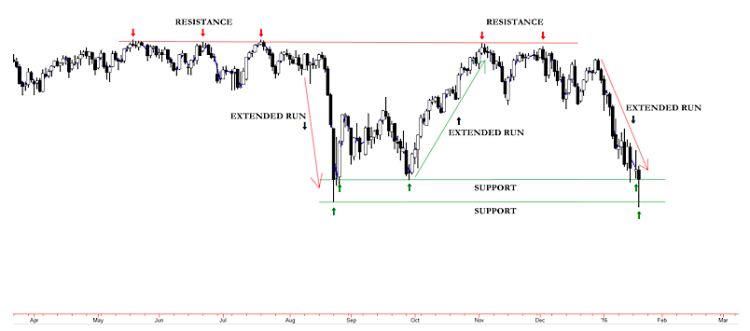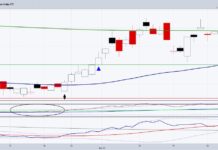Navigating The “CHOP CHOP” Stock Market
The CHOP CHOP market is so named because it has a tendency to “chop up” both the trader’s mental and trading capital. It is the market phase where traders experience the most anxiety and choppy markets tend to see them lose the most money.
This often leads to emotionally charged trading decisions that can have disastrous consequences.
The CHOP CHOP market most often occurs after an extended run to a major support or resistance area where indecisiveness is the main characteristic behind erratic and volatile day to day price action in the stock market…and sometimes choppy markets persist.
Let’s take a look at the chart of the S&P 500 Index as an example. Here you can see the major support levels and price action on the broad stock market index.
S&P FUTURES: DAILY CHART
During these periods of choppy markets, traders lose the most money and experience the most anxiety for the following reasons:
- They missed the breathtaking run where stocks can experience huge percentage gains and losses. Seeing these runs, after the fact, they feel left out and are now ready to jump on board, only to realize that they are the last ones to do so as the market begins to slow down or even reverse. The fear of missing out on a rising stock market or popular momentum stocks is suddenly replaced with buyer’s remorse. They are buying when the majority is selling or they are selling when the majority is buying. Therefore, choppy markets can accentuate the size of a trader’s losses.
- They were on the wrong side of the market to begin with and chose to hang on to their losers until they just could not take the pain anymore. When the pain of loss is no longer possible to bear these traders dump their losers, deciding that if they can’t beat them then they may as well join them. Unfortunately, they decide to join the other side at the worst possible time. The pain of staying in too long is replaced with the realization that the previous painful journey may be nothing compared to pain of the new one, as insult is added to injury.
- Those who were on the right side of the trade have enjoyed the euphoria associated with letting their winners run and are not yet willing to give it up. Not wanting to come down from their trading high, these traders continue to trade as if the party will never end. However, the party does end and most of the money made during the previous run are given back when the stock market decides its time to rest or run in another direction. For the euphoria to continue these traders put on more trades than usual, since most are now failing, thus leading to overtrading and revenge trading, neither of which cure these traders of their hangovers.
So, what is a trader in one or more of these situations to do?
First and foremost it is important to remember that no one can predict the future. Calling tops and bottoms is nothing more than the ego’s attempt to outsmart others by being the first to do so. While a correct top or bottom call may make headlines, the 15 minutes of fame associated with it will not make for consistent profitability. Traders make money by managing the future, not by predicting it.
Second, traders should focus on the key support and resistance areas of the major indices, as most stocks will be affected by them in much the same way. For instance, if the major indices begin to sell off at a previous resistance level most stocks will do the same. Knowing the key levels can help traders make better decisions about entries and exits, even if the market is volatile or choppy markets persist.
Third, traders should work on recognizing when a trading edge has lost its ability to produce profits due to changing market conditions. Markets run and markets rest. Trend trades work best when a market is running; therefore, when the trend comes to an end or the run turns into a rest, such as at a support or resistance level, traders should be prepared to make adjustments. Successful traders allow the price action to alert them to a change in market character. So, if what has been working, such as a trend breakout, begins to fail, then an obvious change in market character is most likely afoot. The sooner traders recognize a change the sooner they can make the adjustments necessary to get them back on the right side of the trade, either by waiting on a trend continuation or by spotting a potential trend reversal.
Successful traders quickly adapt to changing market conditions. They do so by recognizing when their actions are in response to pain, regret, impatience, revenge, fear, greed, and any number of other emotionally charged decisions. Once they gain control of their emotions then, and only then, will they be able to adjust their trading edge (e.g., take profits, exit losers, wait for confirmation) to suit current market conditions. Check out my trading course for more information on navigating tough markets. Thanks for reading.
Twitter: @crosshairtrader
Any opinions expressed herein are solely those of the author, and do not in any way represent the views or opinions of any other person or entity.









